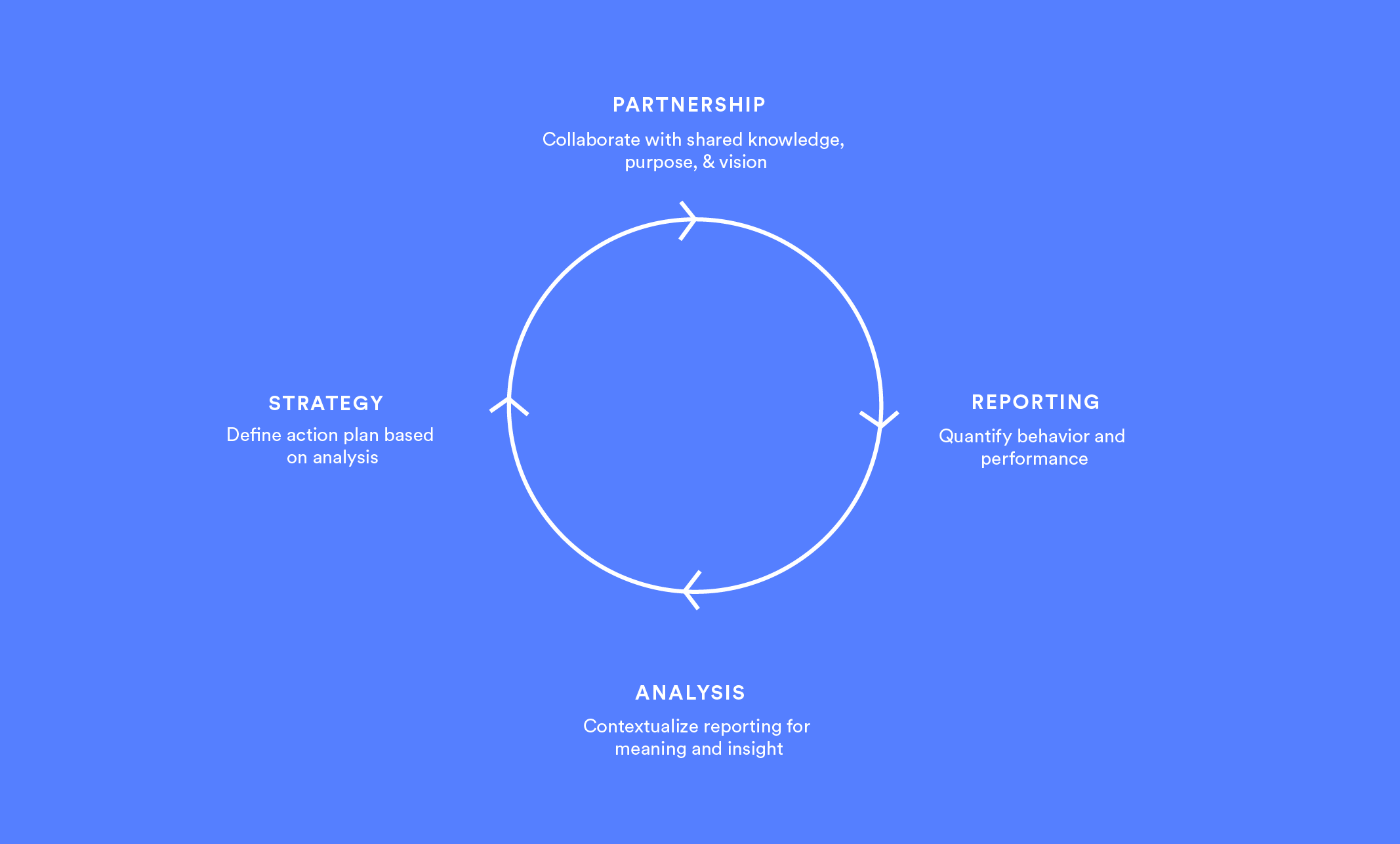In 2011, a McKinsey Global Institute report celebrated the potential for big data: “…we are on the cusp of a tremendous wave of innovation, productivity, and growth, as well as new modes of competition and value capture…”
Companies have been making huge investments in technology, especially big data, analytics, and artificial intelligence, with an expectation of achieving a competitive advantage. Unfortunately, progress has not met expectations. Despite increased spending, many are failing in their efforts to become data-driven. The authors of a February article in the Harvard Business Review lament that progress is even worse than previously thought, citing the Big Data and AI Executive Survey 2019 in which 69% of senior executives say they have failed at creating a data-driven organization.
It’s clear that becoming data-driven takes more than amassing data and buying a few tools. On top of building a solid, accurate, well-integrated data infrastructure, it also requires leadership to understand fully what it means to be data-driven and how to move systematically in that direction.
So perhaps we should take a step back and examine what data-driven means and how companies should proceed in order to use data for growth.
Go Beyond Gut Instinct
While some still prefer to trust their experience and gut instinct, analytical decision making consistently produces the best results.
But because being data-driven is about using facts and evidence to aid decision making and arbitration, we can’t ignore the role human judgment and interaction play. Very rarely does a computer spit out the answer about where opportunities are, much less what to do about them. It can’t say which initiatives to support, how to best deploy marketing dollars, or who to target and with what offer. But computers can drive insights from data to help make those decisions with confidence.
Data can also make it easier to resolve differences of opinion. Rather than simply deferring to the most senior or most vocal person in the room, you can approach challenges and opportunities logically, allowing the facts and evidence arbitrate confusion or disagreement.
Build a Data-Driven Organization
Being data-driven is first and foremost about process and culture. We’ve seen organizations with a data-driven culture and well-defined processes accomplish remarkable gains with relatively limited data sets and modest technology. On the other hand, we’ve also seen organizations with rich data sets and the best tools fall short because they don’t have those processes and/or culture.
All data-driven organizations embody four interdependent and synergistic characteristics.
- Reporting (data): They can answer questions about behavior and performance
- Partnerships between analytics teams and business owners: They are organizationally and operationally aligned, and collaborate with shared knowledge and vision
- Analysis: They provide context to data that tells a story about what’s going on
- Strategy: They effectively use that story to yield further answers or actions

Reporting
It’s an understatement to say that data in the form of reporting is critical. Knowing your conversion rate, number of leads or revenue generated, return on ad spend, revenue per customer, or what customers are engaging with and buying is essential to understanding performance. However, many firms struggle in two primary areas of data and reporting.
The first is their reporting doesn’t go far enough. There is increasing pressure and opportunity to expand beyond isolated channel reporting to a model that more accurately reflects the scope of journeys and experiences linked to bottom-line business goals. The level of disintegrated reporting that exists is ironic in an era of hyper-integrated engagement and marketing.
High-performing brands integrate and track the impact of experiences broadly with the ability to drill down within specific channels or moments on metrics such as LTV, CSAT, churn, ROI, sales, and revenue. In B2B, for example, there is an increasing trend away from using form completes and lead gen volume as the primary proxy for marketing performance, looking instead to revenue and SKUs as the success metric.
Attributing a ton of leads to specific campaigns is great, but knowing which of those campaigns actually drove sales, by whom, how much, through which products, and by what purchase path is much more accurate, insightful, and actionable.
The second is that reporting is too often approached as an end state rather than the starting point. Reporting doesn’t tell you what to do next. It doesn’t provide context. It’s common to hear organizations say: “It’s nice to know my conversation rate is X or average transaction amount is Y, but I don’t know what to do about it. I don’t know what’s driving it or how to respond.”
Even in the best circumstances, reporting does not address this challenge. Anyone can go to web analytics, marketing automation, email, Salesforce, or a Tableau dashboard and read out the numbers. But what do those numbers mean? How do you leverage that information for insights you can use now? What opportunities exist that you can capitalize on?
Answering those questions requires partnerships and analysis.
Partnership
One of the most overlooked requirements to fostering a data-driven culture is the formation of strategic partnerships between analytics and business units.
Organizations that complain about being awash in data without insights typically have siloed data and analytics teams whose purpose is almost exclusively implementation and reporting – either by design, or simply because the analytics team is overwhelmed generating reports for business units.
These teams have to collaborate and partner on fundamental business issues in order to drive success. Both need to be on the same page in terms of business goals, KPIs, priorities, and strategy. It’s even more important for these teams to build and develop intimate knowledge of audiences, their needs and behaviors, how they differ across segments, their experiences, and the impact of those experiences on behavior.
Data-driven organizations foster partnerships and collaboration across business units, sales and marketing, analytics, and creative teams.
Analysis
Analysis is fundamentally about asking questions and searching through data for answers – or more likely, potential answers. And the analysis and insight are only as good as the questions asked.
The questions might start at the highest level, such as “how can we increase conversion rate and/or increase average order value (AOV)?” But the analysis should proceed to ask and probe additional questions like how conversion rates vary by traffic source, by type of content engaged, messaging frequency and channel, CTAs, segment, internal and/or paid search terms, creative, form or check-out experience, navigation, and on and on.
In this way, the analysis begins creating context to the reports and data being generated, out of which additional questions emerge to further focus the analysis and generate insight.
Let’s say the analysis leads to the observation that a disproportionate number of visitors entering your online shopping process add items to their cart, only to remove them just before checkout. That’s a potential opportunity for performance improvement. The next question is why?
Perhaps further analysis reveals the possibility (i.e. hypothesis) that the UX and text are creating confusion. Now we have a story based on data and analysis. We’ve gone from reporting pure numbers on conversion rate and AOV, to telling an insights-driven story about the impact of CX on behavior and performance. (We actually identified this exact issue for a client and after addressing it, dramatically increased conversion rate and AOV.)
But what do you do about it?
Strategy
Strategy answers the question about what to do next. It doesn’t necessarily mean pulling in someone with “Strategy” in their title. It’s simply about how you are going to respond to the insight or observation.
What is the hypothesis for factors impacting behavior and what are the ideas and options for capitalizing on it? This typically involves a test, which needs to be defined, evaluated, and planned. What is the test, how should it be structured, what data or creative assets are required, what’s the level of effort, what are the success metrics and expected impact? This is the job of strategy, which is often a collective effort across teams.
Making your organization data-driven doesn’t have to start with a massive overhaul, but it does require process definition and alignment, collaborative partnership, a commitment to analysis, a solution-oriented approach to strategy, and data. Focus on building out these components and your data and analytics maturity will evolve quickly and performance will accelerate.
—
Read more ways to make your company data-driven and check out our Data + Insights offerings.








